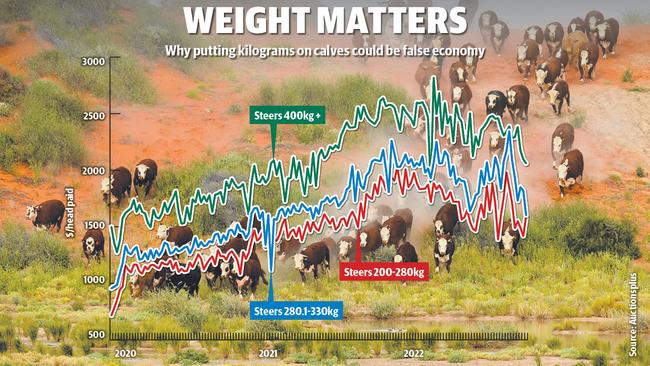Insight: Why putting weight on lambs will pay greater dividends
If recent sale results are to be a guide the smart approach is to feed the lambs and hold onto cattle.
Starve the calves and feed the lambs to take advantage of the unusual price trends being recorded at saleyards this season.
Weight has become a big issue at livestock markets and opposing outcomes are evident for weaner steers compared to what is happening for lambs.
In the lamb market, buyers are rewarding weight and fat cover amid limited supplies of decent heavy processing stock after the wet and disrupted spring.
It was glaringly evident again at Bendigo on Monday where out of a yarding of 16,000 lambs no more than about 10 per cent were decent heavy weights with the bulk either plain washed-out trades or light store lambs of varying quality. It was one of the most extreme ratios of store to fat stock seen at such a major selling centre in the midst of what is meant to be the ‘spring flush’ of prime suckers.
Now the opposite price reward pattern is showing up for weaner steers as the industry heads into a big flush of summer calf sales.
Store buyers are setting dollar per head limits for calves, meaning price points for heavier steers have rolled back to be closer to the middle and third runs.
It was evident at the special Black Friday Angus steer sale at Euroa last week, and was backed up by data from the latest AuctionsPlus online results.
Consider this. The dollar per head average paid on the ‘box’ last week for 1487 light steers in the 200-280kg liveweight range was $1594. Costing nearly exactly the same at an average of $1598 per head were the 2055 heavier young steers in the 280-330kg range. Using the c/kg data meant that for an extra $4 buyers were getting an additional 46kg of calf – and that is not a mistake.

The average cost for the $1594 steers was 627c/kg liveweight, according to AuctionsPlus results. This works out to a calf weight of 254kg. The average cost for the $1598 steers was 531c/kg, working out to an average of 300kg.
Such a convergence of price reflects dollar per head buying as cattle traders move to protect themselves from the uncertainty and volatility of the beef market, and to try and carve out a margin working on lower returns for feeder steers and bullocks.
The scenario put to The Weekly Times at Euroa was that on a ballpark return of 500c/kg for feeder steers at an average of 460kg live weight gives a gross return of $2300. For bullocks the rate is more like 450c at 650kg live weight for a ballpark return of $2900. Roll this back and it means most buyers want to be in a range of $1500 to $1900, which creates the gross return of around $700 to $1000 for a year’s work and costs to grow out and fatten.
The reluctance of buyers to pay more than $2000 for weaner steers was quickly evident at Euroa last week, with only half a dozen pens creeping over this money to a top of $2040.
The opening pen of Angus steer weaners, the heaviest in the yarding, sold for $1990 to work out at 475c/kg liveweight. Yet in the middle runs, there were 340kg steers making $1880 (552c/kg) and 314kg steers $1820 (579c or $1/kg more than the heaviest).
The overall sale average for the 2300 steers at Euroa was reported at $1830 – not bad considering only a couple of hundred sold above $2000.
The weight issue is important for two reasons. There were breeders who held back some lighter calves at Euroa out of concern they could be harshly dealt with price-wise, when in fact the opposite proved true. Prices for the middle and lighter run weaner calves helped support vendor price averages, and it is something for other southern breeders to consider as they face up to the January sales.
For buyers, depending on their program, the weight issue is about the best bang for their buck.
Euroa agent Mick Curtis said the best value appeared to be in the heavier steers, particularly for bullock producers who don’t face the same restrictions on weight gain as those targeting specific feedlot orders.
“The heavier calves did look the better value as the 300-340kg steers were making $1750 to $1850 and the 340-380kg were often costing just $50 to $80 more,’’ Mr Curtis said.
“If I was doing a bullock job I would be targeting the heavier calves for sure.
“For people doing a background feeder job they do have to get down their dollar per head spend now that rates for feeders have slipped back so much.’’
The bottom line is that livestock weight is playing a significant role at all livestock sales at the moment. To all the do-gooders the ‘starve the calves and feed the lambs’ line was just a play on words to make an important point.




